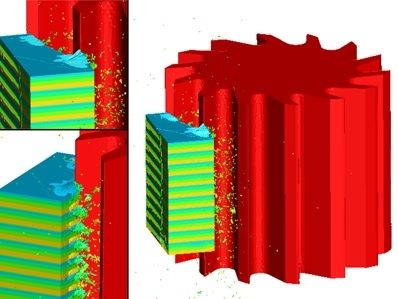Third Wave Systems Models and Optimizes 5-Axis Machined Composite Components

In 2013, Third Wave Systems (TWS) was awarded a $3 million contract by the United States Air Force Life Cycle Management Center, one of the largest funded projects in the company's 20-year history. The focus of the project was to expand Third Wave Systems' metal-cutting solutions to polymer matrix composite (PMC) materials used on the latest warfighter programs. The Department of Defense Rapid Innovation Fund (RIF), which was designed to transition innovative technologies that resolve operational DoD challenges, allocated funds for the contract.
Developed under the RIF, Third Wave Systems software products reduced machining cycle times by predicting and managing forces and predicting composite behavior. Engineers from Third Wave Systems successfully demonstrated improved production processes for several current warfighter PMC components. The improved processes utilized in-place machining equipment, obtained greatly improved part quality and surface finish, reduced tooling costs by 27 percent and reduced cycle-time on milling operations by 47 percent.
A business case extrapolation was performed using current warfighter programs, estimating that the bottom-line savings that could be achieved using Third Wave Systems demonstrated improvements would be substantial. Using an assumption of 35 percent composite machining cycle-time savings (actual achieved was 47 percent), the business case ROM result (based on average price-per-pound of final aircraft composite weight) is an estimated $1.989 million per aircraft savings (current warfighters are ~35 percent composite materials). The results delivered by Third Wave Systems met all proposed goals and exceeded expectations, and was successfully transitioned to production at a major OEM. Third Wave Systems used its existing software as the technology platform. The software was used to model the machining of PMCs at the tool-workpiece level and machining was completed to validate the model outputs. Engineers also modeled PMCs at the toolpath-level and the analysis gave engineers the ability to model CNC machining operations on full part programs. Engineers were then able to predict and optimize forces and temperatures during machining and control them through feed and speed selection.
Additionally, Third Wave Systems also used their modeling technology to select cutting tool strategies to eliminate part delamination and improve quality. Working closely with Third Wave Systems throughout the two-year project were several warfighter component suppliers, including GKN Aerospace, who was the primary project partner. Third Wave Systems developed, validated and implemented a physics-based machining model of the Cycom 5250-4 bismaleimides (BMI) composite material. Additionally, Triumph Group along with major composite machining supplier Janicki Industries worked with Third Wave Systems to perform similar activities for resin systems Cycom 977-3 and AFR-PE-4.
With approval from the Air Force Program Manager, Third Wave Systems also completed a brief experimentation in modeling composites drilling for a project partner's supplier that had experienced devastating quality issues from their baseline drilling process. The drilling experiment was 100 percent successful for this application. While the initial results are promising, showing 56 percent cycle-time reduction and 100 percent quality improvement, more work still needs to be completed to validate the findings and incorporate composite drilling into the software. However, a major advantage is that the drilling technology will be developed using the same physics-based modeling approach. This means the development risk is low and production implementation will be efficient and require no new hardware.





